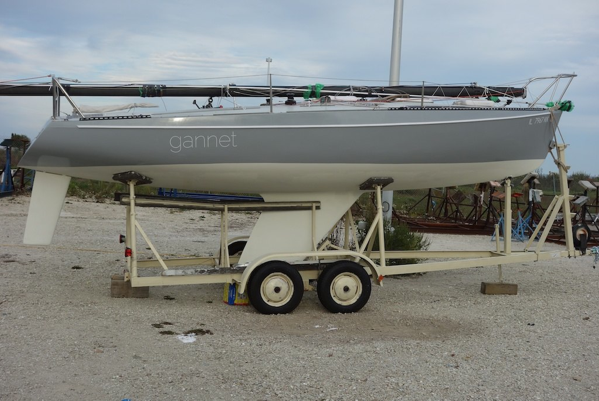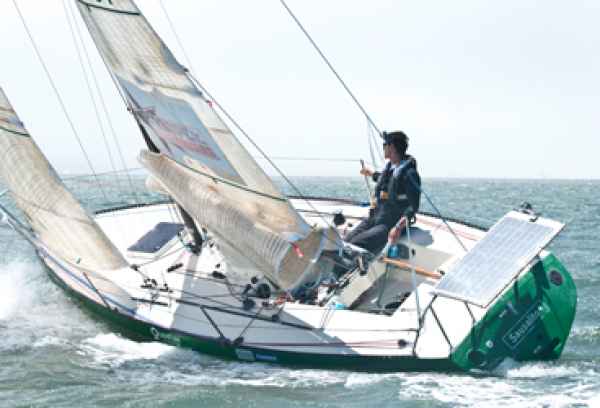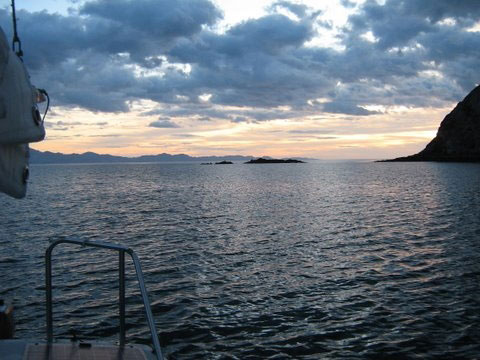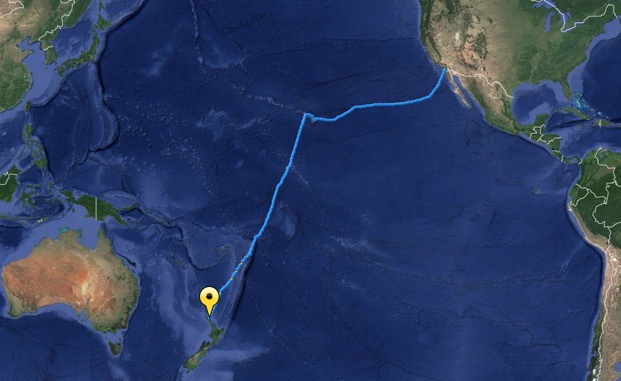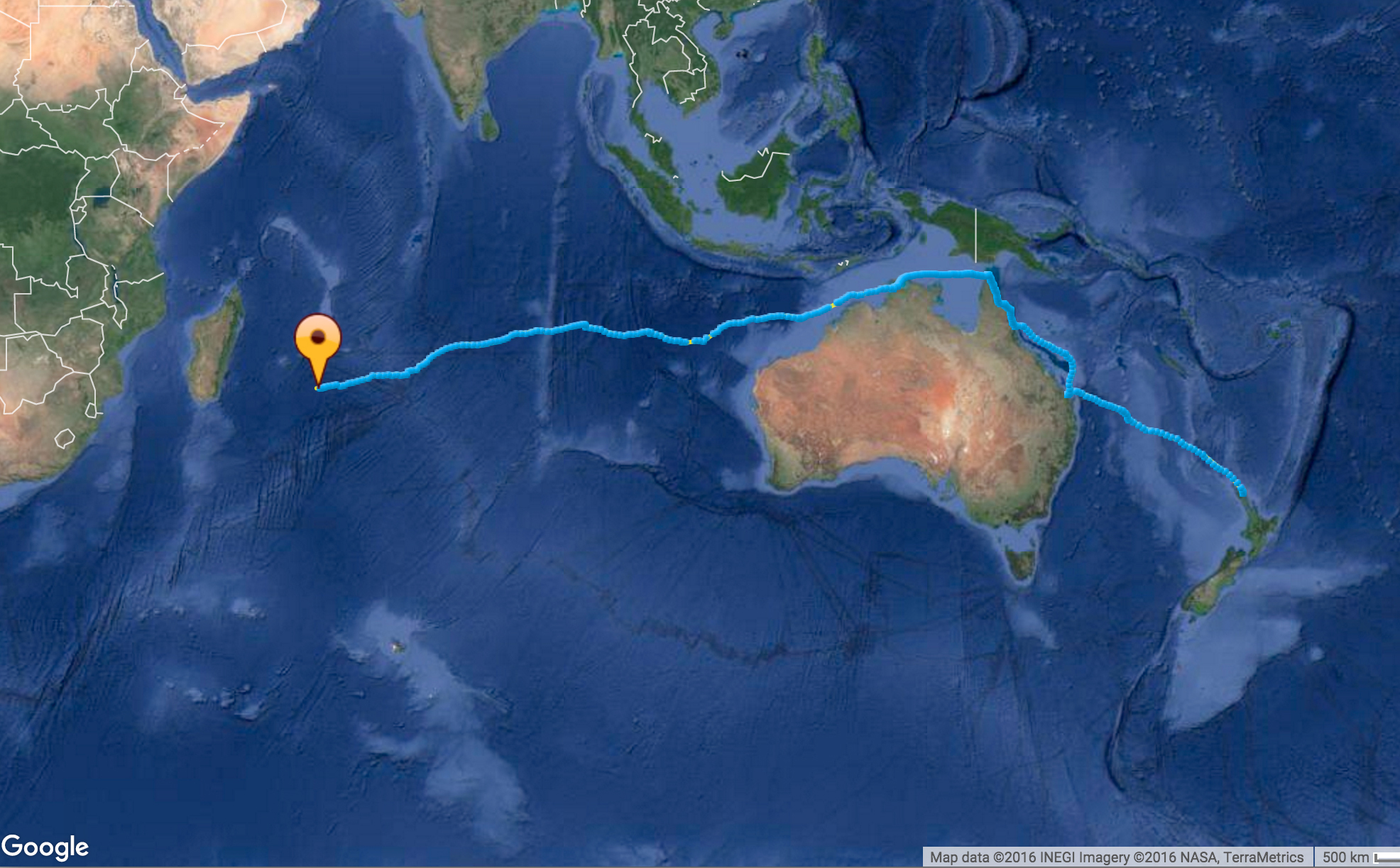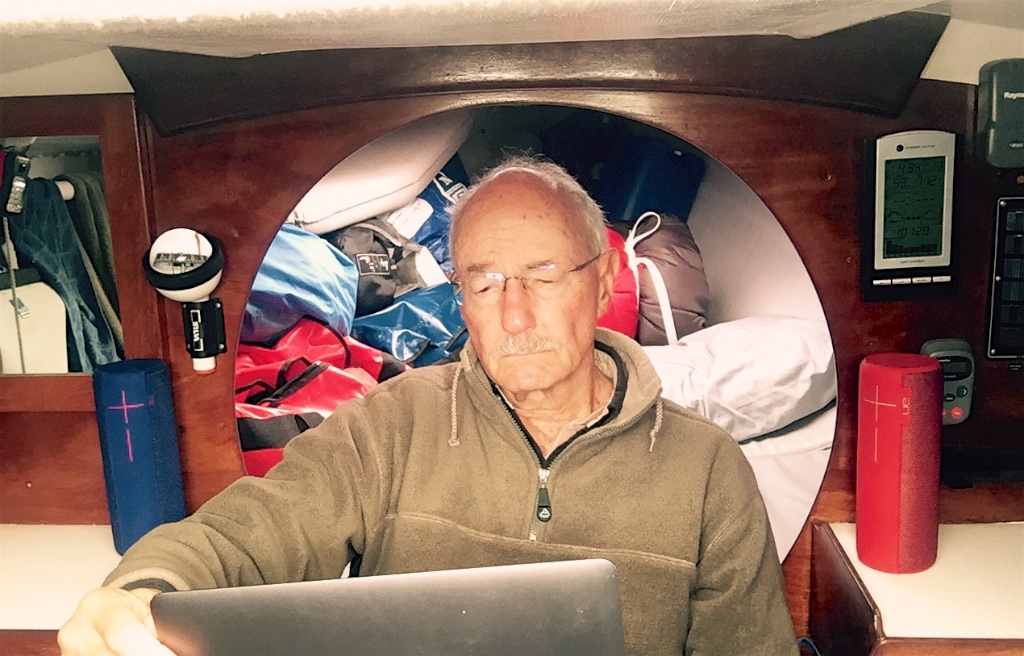My first glimpse of GANNET, as I would name the Moore 24 I had agreed to buy sight unseen five months earlier, was in a rear view mirror, and my first thought was: ‘She is even prettier than I expected.’ Then I jumped out of the car in which I was sheltering from cold early May rain and chased her disappearing transom around the boat yard until Steve Diamond, her then owner, found a place to park the trailer which he had driven from Duluth, Minnesota to Winthrop Harbor, Illinois, near the Wisconsin border.
A few minutes later, I stepped down into her cabin--it is only a single step--and thought: this is even bigger than I expected. I might well be the only person ever to think that of a Moore 24; but then I once lived aboard and sailed thousands of miles in an 18’ undecked Drascombe Lugger. Bigger in volume, not headroom. I had not expected standing headroom, but I didn’t even quite have sitting. More slouching. And obviously dozens of through deck bolts were going to require cap nuts or my head would soon be bloody as well as bowed.
Inspection over, a check was written and I became a two-boat owner, one in each hemisphere, commodore as it were of a world wide fleet. The other is THE HAWKE OF TUONELA, a 37’ Heritage One Ton I base in New Zealand.
I’d harbored vague thoughts about buying a second boat ever since Carol, my wife, and I moved from Boston to an Evanston, Illinois condo a few blocks from Lake Michigan in 2006; but it wasn’t until I completed my fifth circumnavigation in 2009 that I started to take them seriously.
If I bought a second boat, I wanted her to be small, simple, strong, sail well, be offshore proven even though at least initially this was to be a lake boat, and, as always with me, inexpensive.
I considered buying another Drascombe; but an online ad at Sailing Anarchy of a Moore 24 for sale on Lake Huron caught my eye. I did some research and learned that Moore 24s, of which 156 were built by Rob Moore in Santa Cruz in the late 1970s and 1980s, are considered the first of the ULDBs. Mostly a West Coast boat, with still active fleets in San Francisco and Seattle, they have won races, included some to Hawaii, from their first launching to the present. Capable of surfing downwind, they often finish boat for boat ahead of much bigger competitors.
In time I received emails from several Moore 24 owners and sailors, who were unanimous in their praise and affection for what they consider to be very special boats. Many said the best boat they had ever owned, big or small. One wrote simply: ‘she will take you most anywhere you want to go and she will bring you back.‘ That she would also do so at times making ten to twenty knots was even better. I wanted new experiences and a boat from which I could learn.
I was on THE HAWKE OF TUONELA in New Zealand when I first saw the ad and before I returned to the U.S. that boat had been sold. With such a reputation and following, reasonably priced Moore’s don’t stay on the market long.
Three or four were available on the West Coast. At the right price I could afford to buy one there and have it trucked back to the Midwest; but I ran a “boat wanted” ad and received an immediate response from Steve Diamond who owned hull number 40 on Lake Superior.
By now it was December. I considered--briefly--flying to Duluth and looking at the boat, which was stored outside under a wooden frame and tarpaulins, before deciding that I wan’t going to learn anything useful shivering in the dark with a flashlight. Some questions were answered by email; detailed photographs sent; and a deal was made, subject to my eventual inspection.
In the course of this, I realized that I have never sailed a boat before I bought her. This wasn’t even the first I had bought unseen. Two of my first three boats, including EGREGIOUS, the Ericson 37 in which I completed my first circumnavigation, were ordered from line drawings before they went into production. And I have not been disappointed.
I drove home and that night I couldn’t sleep. Not from excitement, but from being overwhelmed by all the details that seemingly had to be solved all at once. Of course they didn’t; but they filled my mind with an endless and widening circle: getting her rigged; launched; propelled; refurbishing her interior, which I had known needed attention; modifying her minimal electric system; batteries; solar panels; cooking; anchoring; setting her up for single-handing; trailer storage and winter storage, which are related because by signing an agreement for winter storage I would not have to pay for summer trailer storage--no boats remain in the water in Chicago marinas year round; and on and on.
Carol and I drove back north the next day, and I got a little better understanding of the boat. But no boat mast down in a boat yard is actually a boat. She is a bird with a broken wing, or, less romantically, a disassembled machine. And so although GANNET was mine, I don’t quite feel it; and didn’t expect I would until she was floating in her slip; or even better under sail, cutting through fresh water, her small tiller in my hands.
When overwhelmed, I have learned to do something, one thing, and then do another; so when I next went to the boat yard, I tried to figure out how to lock her companionway, an unexpected and oddly complicated problem, and I removed her former name and home port from the hull. Fortunately these were decals and came off easily.
Just as I was about to leave that afternoon, I noticed a two inch chip in the epoxy covering her keel, which I expect came when she was lowered by crane onto her trailer. With a bolt on keel, this was not serious, but I drove to a nearby WEST store and bought some filler, which I applied and smoothed as well as I could with a paint stirring stick. Over the almost eighteen years I have owned THE HAWKE OF TUONELA, I have collected all the tools I need for her; but I did not yet know what I would need for GANNET. In fact when you own the same boat for a long time, you forget all the work you’ve put in and the problems you’ve solved over the years. But, as I reminded myself, I wanted a new challenge and not just to sing the same old song like an aging rock star the hits of his youth.
The first priority was to get the boat rigged, launched and in her slip, where I could sort her out enough for the second priority, taking her for a sail, before taking everything moveable off her and starting from scratch.
A helpful Moore 24 owner sent me an email with good advice about how to raise her mast and rig her, but I wanted to let a professional do this the first time to provide a point of reference. I was glad I did because when the mast was up, it was raked much more than I would have expected.
Another immediate priority was auxiliary power.
While THE HAWKE OF TUONELA has a two cylinder Yanmar diesel which has proven reliable, I don’t like engines and I particularly don’t like outboards and have not owned one for more than forty years. Now I owned two: a 1996 3.5 horsepower Yamaha, which I was told has a tendency to stall; and a museum piece 2 horsepower Mariner, which is “completely reliable.” This proved to be the true. When I gave the Mariner to the boat yard to test, it started right up.
However carrying the outboards around even briefly reminded me how much I do not want to have to mix and store gasoline and oil.
The auxiliary power on CHIDIOCK TICHBORNE, my 18’ Drascombe lugger, was a pair of oars. While GANNET weighs about twice what CHIDIOCK TICHBORNE did, I thought that I could row or scull her, too. However, North Point Marina, where I had leased my summer slip, has 1500 slips, making it the largest fresh water marina in the world. That is a lot of craft using one narrow entrance channel, so “sailing, rowing, sculling and paddling” are all prohibited in the marina.
In a couple of magazines I saw articles about the German Torqeedo electric outboards. Further investigation revealed them to be light, modular, waterproof, clean and quiet. Their limited range was more than enough for me. Their relatively high cost caused hesitation. But as the commercial ought to say: “Not having gasoline on board: Priceless.” So I placed an order.
And then I waited for several days while the wind blew too hard for the yard to launch boats.
Gannets are handsome birds with large sleek white bodies, yellow heads, black tipped wings.
I believe the first time I saw them was when we herded hundreds sitting on the water ahead of us while sailing from Durban to Port Elizabeth in 1987.
One of the many pleasures of life on my mooring in New Zealand is sitting on deck with a sunset drink, watching gannets glide overhead, seeking their own evening meal. They dive from height and hit the water like cannon balls. They do not bicker and steal like seagulls or beg like ducks. They hunt solitarily and honorably. I admire them.
So after a lifetime of esoteric boat names--EGREGIOUS; CHIDIOCK TICHBORNE; RESURGAM; THE HAWKE OF TUONELA--for what is likely my last boat, I choose one that requires no explanation.
With GANNET come many things I have not had for decades or ever: insurance--required by the marina. Full coverage, hull and liability: $181 a year. I haven’t had hull coverage on a boat since 1973. A marina slip: pricey at about $2000 May to October. I haven’t had a marina slip since leaving Boston in 2001. A trailer. Never. Outboard motors. Not since trading in my first boat in 1969. And when I bent on sails, jibs with hanks, which I last had on EGREGIOUS in 1976.
Finally the winds abated enough for the yard to launch the little boat and she made her first voyage. Carol sailed it solo. It was not a very long voyage. Eight boat slips. And it didn’t last very long. That GANNET sailed was unexpected.
When we drove up to the marina, I saw GANNET’s distinctive mast from the dock gate and thought it was too close to shore. The boat yard men had put her in slip I-24, not I-32 where she belongs.
The marina was far from full and fortunately the slips between I-24 and 1-32 were vacant. I tied together three lines to bridge the gap, secured one end to a cleat on I-32 and the other to GANNET’s starboard bow line and pushed her back out of the slip, with Carol aboard at the tiller.
There was almost no wind under a lowering sky and I planned to pull GANNET to her proper home; but to our surprise the little lightweight boat with her smooth bottom began to gain way ahead of a bare breath against her mast and hull. All I had to do was walk around and pull in the slack as Carol steered into I-32. Pretty nice. And then it began to rain.
A few showers were heavy enough to drive us into the cabin, but mostly I worked in light drizzle and got the boom, solid boom vang, halyards, lifelines, dock lines, fenders and a few other things sorted out.
Before we left I removed the old Mariner outboard from the outboard bracket and found the wood pad on the bracket to be split. That was easily replaced.
As we left, the sky began to clear.
The Torqeedo Travel 1003 arrived and on my next trip to the boat, I put it on the bracket and started it up. No pulling on a cord. Press a button, turn the tiller handle, and you are in business. The motor is not completely silent. It makes a whirring sound. But it is incomparably quieter than a gasoline outboard.
The defining act of the owner of a new-to-him or her boat is not sailing her; it is spending money. Almost all of mine went duplicating things I already owned on THE HAWKE OF TUONELA, one of the downsides of a two ocean fleet.
On the drive back home, I carried GANNET’s small 35 amp gel cell battery with me, and stopped to buy a battery charger and a DC electrical meter, which told me that the battery was almost fully charged. I gave it a boost anyway.
From Amazon arrived two MightyBright LED Kindle Edition clip-on lights, which have two levels and live up to their name. I often use two to illuminate THE HAWKE OF TUONELA’s cabin and these are more than enough for GANNET.
On a UPS truck came an Avon RedStart dinghy.
As GANNET is likely my last boat; this is likely the last of the series of RedStarts I have owned over the decades. I bought my first so long ago that it cost $250 new. They are now more than six times that. There are two on THE HAWKE OF TUONELA, one fourteen years old and one two or three years old. I thought of bringing the old one back from New Zealand with me, but had enough to carry and like having a spare on THE HAWKE OF TUONELA.
I considered buying something cheaper for GANNET; but RedStarts, even as now made by Zodiac, are by far the best small rowing inflatable. One online chandlery responded to my request for a quote on a RedStart by telling me that they are now made Zodiac, which I already knew, and trying to sell me something cheaper. My reply was curt.
I am conscious of putting weight on GANNET; but Moore 24s are often raced with a crew of four or even five. The maximum permitted total crew weight is 825 pounds, and this puts me about 670 pounds ahead. While crew weigh is movable and useful on the rail going to windward in heavy weather, I will keep as much as I can centered and low.
I have also taken into consideration the requirements for boats racing in the single and double-handed Transpacs. They must have life rafts. I have only had a life raft on THE HAWKE OF TUONELA because Carol wanted one when she sailed with me. Having survived for two weeks adrift in an inflatable during the open boat voyage, I don’t believe that life rafts are often key to survival. The Avon will be mine.
I will also be replacing the small battery with two bigger ones. Again, I have read that the solo Transpac requires two batteries totaling 120 amp hours. I will have two AGM batteries totaling more than that.
And I will add a real anchor. As of yet I’m not certain what; but a properly sized anchor for GANNET will weigh less than 15 pounds. I will anchor her on a mostly line rode, with a small amount of chain at the anchor end, rather than the all chain I prefer. That is weight she cannot carry.
With all this, she will still be lighter than a fully crewed boat.
I bought all this stuff, and more: some tools; simple instruments; name decals; whipping twine; new jib halyards; etc; etc; etc; while waiting for masses of warm air from the Gulf of Mexico to stop colliding over the Midwest with cold air from Canada.
I did not want my first sail on GANNET to be an ordeal, nor to subject Carol to one. But finally I gave up waiting.
On the first Saturday in June, thunderstorms with gusts to 40 knots, torrential rain, and golf ball size hail were possible. At Winthrop Harbor, where North Point Marina is located, the chance of rain was 40%. But I have learned that the Chicago metropolitan area is so big that the world could come to an end in one part while another remained untouched.
In Evanston the morning was sunny and the sky clear. Internet radar images showed a band of rain in eastern Iowa, and as we drove the forty miles north to the marina haze and a few clouds formed to the west.
But when we got to the boat the wind was light and apocalypse did not seem imminent.
I fit the Torqeedo to the outboard bracket, untied the dock lines, and pushed GANNET out of her slip.
Handling the throttle on the Torqeedo and the tiller on GANNET was easy. One hand on one, one on the other. The distance is short.
Slips at North Point are smaller as they are more distant from the breakwater entrance. GANNET lives on ‘I’ Dock, which is the second farthest inland. We powered slowly up the main channel. The Torqeedo had plenty of power to move the hull, and the display on the GPS equipped tiller arm indicated the relationship between speed and range. At less than two knots, we could power thirty miles. At five knots, less than five miles. I did not find it difficult to obey the no wake rules.
Harbor master emails had warned that near record low water on Lake Michigan and silting in the breakwater entrance had resulted in unusual placement of marker buoys; but even so as we made the turn to port I was surprised to see the marked channel reduced to less than a third of the possible width. Followed by three or four power boats and without a working depthsounder, we kept between the buoys.
We emerged into a glassy, windless Lake Michigan.
With Carol at the tiller, I raised the mainsail anyway, and then a jib.
I had intended to use the number 2 because I couldn’t find the cars for the number 1 track, but I pulled up the number 3 bag by mistake. It didn’t matter. I got the sail up, relishing again how easy it is to hoist the sail compared to doing so on THE HAWKE OF TUONELA, whose mast is twice as tall as GANNET’s, stopped the Torqeedo, and waited for cats-paws a quarter mile north to reach us.
In a few minutes they did and GANNET heeled and came alive. White sails stopped flopping and arched up and out beyond my mind, as they have over decades and oceans. Water gurgled past the hull. Smiles matched our spirits as soon by GPS readings we were making 6 and 6.5 knots in what I judged to be about that much wind. She will sail in a sneeze.
Heading east on a beam reach, we followed the wind as it backed north, then tacked for the marina as a bank of fog formed.
The only unexpected difficulties came from the Torqeedo.
On the advice of a former Moore 24 owner, I ordered a long shaft. Even tilted up this does not quite clear the water, and to get it that far I had to remove the tiller arm. The big propeller makes a substantial sound spinning in the water at six knots and creates an unacceptable drag. Eventually I ran a line around the shaft and tied it to the port pulpit to pull it completely clear, but this caused the battery to pivot to one side.
The Torqeedo breaks down easily into three parts: the tiller arm, the battery, and the shaft. Removing the tiller arm and the battery is easy. Removing the shaft from the outboard bracket and then remounting it underway would not be much fun but would solve the problem. It might be enough to install a small centerline cleat to tie the shaft to. But obviously something will have to be done.
We headed back in after a couple of hours, dropping the sails and turning on the Torqeedo just outside the breakwater. For the year before I left on my first attempt at Cape Horn in 1974, I sailed the 37’ engineless, EGREGIOUS, in and out of her slip at San Diego’s Harbor Island Marina. But for marina rules, GANNET would be even easier to sail in and out, though admittedly not in all wind directions through a narrow bend in the silted entrance.
We were back in our slip on deck talking to our neighbors when I realized that I had just had my first sail on fresh water.
For at least her first two summers, and perhaps forever, GANNET will be a lake boat. Sail GANNET on the Great Lakes in the Northern summer; sail THE HAWKE OF TUONELA in New Zealand in the Southern summer, doesn’t sound too bad. But I have not forgotten that gannets are birds not of fresh water, but salt.



